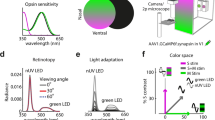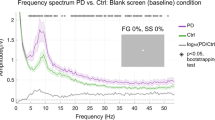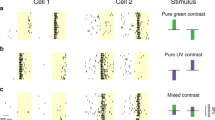Abstract
BLINDSIGHT—the residual visual functions observed in visual-field defects resulting from destruction of part of the primary visual cortex (striate cortex) even though visual stimuli presented in the field defect are not consciously perceived—has generated new insights into the nature of consciousness and the role of the extrastriate pathways in visual processing. Some patients can detect and localize unseen stimuli when they are required to guess1–4. Discrimination of movement5,6, flicker5,7 and orientation4,8 may also be present, but residual colour discrimination is controversial. Negative results (see ref. 9 for review) imply that only the pathways from eye to striate cortex can transmit information about colour in primates. By measuring sensitivity to light of different wavelengths in patients with blindsight we show that spectral sensitivity in the blind fields is surprisingly high, with a reduction of only 1 log unit or less across the visible spectrum. It is also essentially normal in form, whether the patients are adapted to light or dark. The shift in peak sensitivity from medium to shorter wavelengths in adaptation to the dark (the Purkinje shift) and the presence of discontinuities in the light-adapted curve together show that blindsight involves both rod and cone contributions, and that some colour opponency remains. As colour opponency requires input from primate beta retinal ganglion cells, two-thirds of which degenerate transneurally after a striate cortical lesion in juvenile monkeys10, our results show that the surviving subpopulation of primate beta cells is functional.
This is a preview of subscription content, access via your institution
Access options
Subscribe to this journal
Receive 51 print issues and online access
$199.00 per year
only $3.90 per issue
Buy this article
- Purchase on Springer Link
- Instant access to full article PDF
Prices may be subject to local taxes which are calculated during checkout
Similar content being viewed by others
References
Perenin, M. T. & Jeannerod, M. Neuropsychologia 16, 1–13 (1978).
Pöppel, E., Held, R. & Frost, D. Nature 243, 295–296 (1973).
Stoerig, P. & Pöppel, E. Expl Brain Res. 64, 469–475 (1986).
Weiskrantz, L., Warrington, E. K., Sanders, M. D. & Marshall, J. Brain 97, 709–728 (1973).
Barbur J. L., Ruddock, K. H. & Waterfield, V. A. Brain 103, 905–928 (1980).
Weiskrantz, L. Blindsight (Clarendon, Oxford. 1986).
Blythe, I. M., Kennard, C. & Ruddock, K. H. Brain 110, 887–905 (1987).
Perenin, M. T. Neuropsychologia 16, 697–708 (1978).
Stoerig, P. Brain 110, 869–886 (1987).
Cowey, A., Stoerig, P. & Perry, V. H. Neuroscience 29, 65–80 (1989).
Van Buren, J. M. The Retinal Ganglion Cell Layer (Charles Thomas, Springfield, 1963).
Bender, M. B. & Krieger, H. P. Archs. Neurol. Psychiat., Chicago 65, 72–79 (1951).
Keating, E. G. Brain Res. 179, 379–384 (1979).
Schilder, P., Pasik, P. & Pasik, T. Expl Brain Res. 14, 436–448 (1972).
Leporé, F., Cardu, B., Rasmussen, T. & Malmo, R. B. Brain Res. 93, 203–221 (1975).
Klüver, H. J. Psychol. 11, 23–45 (1941).
Snelgar, R. S., Foster, D. H. & Scase, M. O. Vision Res. 27, 1017–1027 (1987).
Sperling, H. G. & Harwerth, R. S. Science 172, 180–184 (1971).
King-Smith, P. E. & Carden, D. J. opt. Soc. Am. 66, 709–717 (1976).
Gouras, P. J. Physiol., Land. 199, 533–547 (1968).
Lee, J. & Strohmeyer, C. F. J. Physiol., Lond 413, 563–593 (1989).
Cowey, A. & Stoerig, P. Expl Brain Res. 75, 631–638 (1989).
Felsten, G., Benevento, L. A. & Burman, D. Brain Res. 288, 363–367 (1983).
Author information
Authors and Affiliations
Rights and permissions
About this article
Cite this article
Stoerig, P., Cowey, A. Wavelength sensitivity in blindsight. Nature 342, 916–918 (1989). https://doi.org/10.1038/342916a0
Received:
Accepted:
Issue Date:
DOI: https://doi.org/10.1038/342916a0
This article is cited by
-
Color vision and color pattern visual evoked cortical potentials in a patient with acquired cerebral dyschromatopsia
Documenta Ophthalmologica (1995)
Comments
By submitting a comment you agree to abide by our Terms and Community Guidelines. If you find something abusive or that does not comply with our terms or guidelines please flag it as inappropriate.



